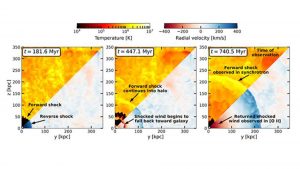In 2019, the ASKAP telescope detected odd radio circles that contained entire galaxies in their centres – now, their origin has been explained by researchers.
A team led by University of California San Diego Professor of Astronomy and Astrophysics, Alison Coil, has determined what the odd radio circles are and believes they know why they are there.
The researchers argue that circles are shells formed by outflowing galactic winds, potentially from supernovae.
The work, ‘Ionized gas extends over 40 kpc in an odd radio circle host galaxy,’ is published in the journal Nature.
Studying massive galaxies
The team have studied massive starburst galaxies that can drive ultra-fast outflowing winds. These galaxies have a high rate of star formation, expelling a large amount of gas when they die and explode.
They found that if enough stars explode near each other simultaneously, the force of the explosions can push the gas out of the galaxy itself into outflowing winds. These can travel at around 2,000 kilometres per second.
“These galaxies are really interesting,” said Coil. “They occur when two big galaxies collide. The merger pushes all the gas into a very small region, which causes an intense burst of star formation. Massive stars burn out quickly, and when they die, they expel their gas as outflowing winds.”
Previous theories about the presence of odd radio circles
In 2019, for the first time, the ASKAP telescope was able to detect odd radio circles (ORCs). Technological developments allowed the telescope to scan large portions of the sky at very faint limits.
The detected odd radio circles were enormous – hundreds of kiloparsecs across, where a kiloparsec is equal to 3,260 light years.
Many theories were proposed to explain the origin of the odd radio circles. These included planetary nebulae and black hole mergers. However, radio data could not discriminate between the theories.
The researchers believed that it was possible the radio rings were a development from the later stages of the starburst galaxies they had been studying.
They began analysing ORC 4 – the first ORC discovered that is observable from the Northern Hemisphere.

Looking into ORC 4
Odd radio circles had previously only been observed through their radio emissions, without any optical data.
The team used an integral field spectrograph at the WM Keck Observatory in Maunakea, Hawaii, to look at ORC 4. The spectrograph revealed a tremendous amount of heated, compressed gas – more than is seen in the average galaxy.
Using optical and infrared imaging data, the researchers found that the stars inside the ORC 4 galaxy were around six billion years old.
“There was a burst of star formation in this galaxy, but it ended roughly a billion years ago,” stated Coil.
Computer simulations were used to replicate the large-scale ring
Cassandra Lochhaas, a postdoctoral fellow at the Harvard & Smithsonian Center for Astrophysics and co-author of the paper, conducted a number of computer simulations to replicate the size and properties of the large-scale radio ring. This included the large amount of shocked and cool gas in the central galaxy.
The simulations revealed outflowing galactic winds blowing for 200 million years before they shut off. When the wind stopped, a forward-moving shock propelled high-temperature gas out of the galaxy, creating a radio ring. A reverse shock sent cooler gas falling back onto the galaxy. The simulation played out over 750 million years.
“To make this work, you need a high-mass outflow rate, meaning it’s ejecting a lot of material very quickly. And the surrounding gas just outside the galaxy has to be low-density, otherwise, the shock stalls. These are the two key factors,” stated Coil.
“It turns out the galaxies we’ve been studying have these high-mass outflow rates. They’re rare, but they do exist. I really do think this points to ORCs originating from some kind of outflowing galactic winds.”
Odd radio circles and outflowing winds can reveal information about each other
Outflowing winds help astronomers understand odd radio circles, but ORCs can also be used to provide more information on outflowing winds.
“ORCs provide a way for us to ‘see’ the winds through radio data and spectroscopy,” concluded Coil.
“This can help us determine how common these extreme outflowing galactic winds are and what the wind life cycle is. They can also help us learn more about galactic evolution: do all massive galaxies go through an ORC phase? Do spiral galaxies turn elliptical when they are no longer forming stars? I think there is a lot we can learn about ORCs and learn from ORCs.”









